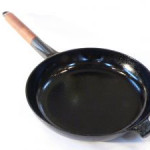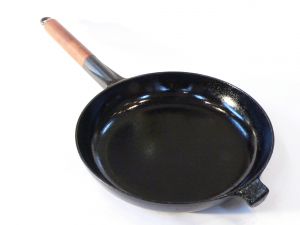Have you ever reached into the cavity of a fresh chicken and found it frozen inside? Poultry can be chilled to 26 degrees and still be considered fresh. Water may freeze at 32 degrees, but poultry flesh doesn’t freeze solid until it reaches 25 degrees. The extra few degrees will lengthen the shelf life of the chicken.
While many cooks are in the habit of rinsing poultry before cooking, it really isn’t necessary. You always cook poultry to a temperature that kills any harmful bacteria. In fact, it could be more dangerous to rinse the poultry, as you can end up splashing contaminated water all over the sink and kitchen counter.
After preparing poultry, reduce the chance of bacteria contamination by washing the cutting board, prep utensils, and your hands with hot, soapy water. It’s a good idea to reserve one cutting board for raw meat and poultry and a second board for other ingredients.
Broiler-fryer chickens are the all-purpose chicken, but you usually see them labeled simply as whole chicken. They used to average 3 1/2 pounds, but these days, you’ll find them up to 5 pounds, which means you get more servings per chicken. Roaster chickens tip the scales at 5 to 7 pounds, and are usually cooked whole in the oven. Even if you are serving a small group, it is worth roasting one of the larger chickens so you have leftovers for other meals.
The standard supermarket chicken is grown according to USDA standards, which allow antibiotics in the feed. Hormones and growth stimulants have been outlawed in poultry production since the 1950s.
Free-range chickens have access to the outdoors, which does not mean they live outdoors. The standards for organic chickens vary from state to state. In general, these birds, which are often also free range, must be fed organically grown feed and raised without antibiotics. Many cooks believe the flavor of free-range or organic birds is superior to that of supermarket chickens.
If you need to roast a chicken in record time, then butterfly it and roast it at a high temperature. With its entire surface exposed to the oven heat, the skin will be crisp and golden brown.
Be sure that whatever vessel you use for roasting a chicken can also be used on the stove top, so you can deglaze the drippings and turn them into a pan sauce. Enameled cast-iron baking dishes are a good choice.
You’ve paid for the entire chicken, so don’t throw anything away. The neck, heart, kidneys, and fat can be turned into quick chicken stock that will make just enough for many recipes, including a sauce for serving with the chicken. Don’t use the liver, as it will make the stock bitter. If you have butterflied the chicken, chop up the backbone and add the pieces to the stock, too. The stock won’t be as rich as a long simmered one, but it’s just fine when combined with pan juices.
Herbs are a wonderful flavoring for roast chicken, but they can burn if simply rubbed onto the skin. Combine the herbs with softened butter, and carefully slip the herb butter under the chicken skin, spreading it evenly. Roast away without worrying about singed herbs.
“Work With What You Got!”
© Victoria Hart Glavin Tiny New York Kitchen © 2017 All Rights Reserved
Some foods need moist, long cooking to tenderize them while others just require a quick sauté in a skillet. Sauté means “jump” in French which describes the tossing and turning in the skillet during the cooking process. There are a few basic secrets to perfect sautéing that will help you get better cooking results.
The trick to successful sautéing is to use a medium-high heat and a small amount of oil. As a matter of fact meats and other protein-based foods should not be turned too often because extended contact with the hot skillet will brown the surface of the food which will deliver extra flavor. Heat the skillet over a medium-high heat and if the pan is too hot you will burn the outside of the food before the inside is cooked so turn down the heat a bit.
Do not use butter for sautéing. Use oil. Butter contains milk solids that burn and smoke at high temperatures. Some cookbooks call for mixing butter and oil which supposedly increases the smoke point of the butter. This does not remove the milk solids that are the problem. You can, however, use clarified butter, but it is easier to use oil for cooking meats. If you want a butter flavor then use it in a pan sauce.
Thick cuts of meat can be difficult to cook through when sautéing. You may want to use a double-cooking method for thick cuts. Double-cut pork and lamb chops, porterhouse steaks, and large bone-in, skin-on chicken breast halves are too thick to cook through in a skillet on the stove top. It is best to brown them in the skillet, and then finish cooking them in a 400° F oven. Be sure that your skillet is ovenproof.
Make a pan sauce to take advantage of the browned bits in the pan which are loaded with delicious flavor. Remove the meat from the skillet and tent loosely with aluminum foil to keep the meat warm. Pour off the fat from the skillet and return the skillet to the medium-high heat. Add a couple of tablespoons of minced shallots and a tablespoon of butter. Do not add the butter alone as the skillet may be too hot and the butter will burn. The shallots will act as insulation. Cook for a minute or so to soften the shallots and then add about 1 cup of an appropriate stock. Wine may seem like a good choice, but it can be too strong. Boil the stock, scraping up the bits in the pan with a wooden spoon or spatula until it is reduced to about 1/2 cup. Remove from the heat and whisk in 1to 2 tablespoons of cold butter (a tablespoon at a time) to thicken the sauce lightly.








